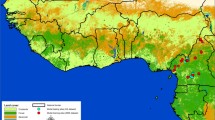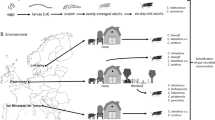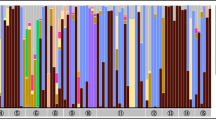Abstract
Mycobacterium ulcerans (MU), the causative agent of Buruli ulcer, is present in a wide spectrum of environments, including terrestrial and aquatic ecosystems in tropical regions. The most promising studies on the epidemiological risk of this disease suggest that some ecological settings may favor infection of animals with MU including human. A species’ needs and impacts on resources and the environment, i.e., its ecological niche, may influence its susceptibility to be infected by this microbial form. For example, some Naucoridae may dive in fresh waters to prey upon infected animals and thus may get infected with MU. However, these studies have rarely considered that inference on the ecological settings favoring infection and transmission may be confounded because host carrier sister species have similar ecological niches, and potentially the same host–microbe interactions. Hence, a relationship between the ecological niche of Naucoridae and its infection with MU may be due to a symbiotic relationship between the host and the pathogen, rather than its ecological niche. To account for this confounding effect, we investigated the relationships between surrogates of the ecological niche of water bug species and their susceptibility to MU, by performing phylogenetic comparative analyses on a large dataset of 11 families of water bugs collected in 10 different sites across Cameroon, central Africa. Our results indicate that MU circulates and infects a couple of host taxa, i.e., Belostomatidae, Naucoridae, living both in the aquatic vegetation and as predators inside the trophic network and sister species of water bugs have indeed similar host–microbe interactions with MU.





Similar content being viewed by others
References
Andersen NM, Weir TA 2004. Australian Water Bugs: Their Biology and Identification (Hemiptera-Heteroptera, Gerromorpha & Nepomorpha) (Apollo Books)
Barker D, Pagel M (2005) Predicting functional gene links from phylogenetic-statistical analyses of whole genomes. PLoS Computational Biology 1: e3
Benbow ME, Williamson H, Kimbirauskas R, McIntosh MD, Kolar R, Quaye C, Akpabey F, Boakye D, Small P, Merritt RW (2008) Aquatic invertebrates as unlikely vectors of Buruli ulcer disease. Emerging Infectious Diseases 14(8): 1247–1254.
Carolan K, Ebong SMA, Garchitorena A, Landier J, Sanhueza D, Texier G, Marsollier L, Le Gall P, Guégan J-F, Seen DL (2014) Ecological niche modelling of Hemipteran insects in Cameroon; the paradox of a vector-borne transmission for Mycobacterium ulcerans, the causative agent of Buruli ulcer. Int J Health Geogr 13: 1
Cavender‐Bares J, Kozak KH, Fine PVA, Kembel SW (2009) The merging of community ecology and phylogenetic biology. Ecol Lett 12: 693–715
Charleston MA, Robertson DL (2002) Preferential host switching by primate lentiviruses can account for phylogenetic similarity with the primate phylogeny. Syst Biol 51: 528–535
Chase JM, Leibold MA (2003) Ecological Niches: Linking Classical and Contemporary Approaches. Chicago: University of Chicago Press
Chen P-P, Nieser N, Zettel H (2005) Aquatic and Semi-Aquatic Bugs (Heteroptera: Nepomorpha & Gerromorpha) of Malesia. Fauna Malesiana Handbook 5, Brill, pp x+546
Cooper TG, E. Noonan, S. von Eckardstein, J. Auger, H. W. Baker, H. M. Behre, T. B. Haugen, T. Kruger, C. Wang, M. T. Mbizvo, and K. M. Vogelsong. 2010. ‘World Health Organization reference values for human semen characteristics’, Hum Reprod Update, 16: 231-45.
Duvirad, Dominique. 1974. ‘Flight activity of Belostomatidae in central Ivory Coast’, Oecologia, 15: 321-28.
Ebong SMA, Petit E, Le Gall P, Chen P-P, Nieser N, Guilbert E, Njiokou F, Marsollier L, Guégan J-F, Pluot-Sigwalt D (2016) Molecular Species Delimitation and Morphology of Aquatic and Sub-Aquatic Bugs (Heteroptera) in Cameroon. PloS one, 11: e0154905
Felsenstein J. 1985. Phylogenies and the comparative method, American Naturalist, 125: 1–15.
Freckleton, Rob P, Paul H Harvey, and Mark Pagel. 2002. ‘Phylogenetic analysis and comparative data: a test and review of evidence’, The American Naturalist, 160: 712-26.
Fyfe, Janet AM, Caroline J Lavender, Kathrine A Handasyde, Alistair R Legione, Carolyn R O’Brien, Timothy P Stinear, Sacha J Pidot, Torsten Seemann, M Eric Benbow, and John R Wallace. 2010. ‘A major role for mammals in the ecology of Mycobacterium ulcerans’, PLoS Negl Trop Dis, 4: e791.
Garchitorena A, Guégan J-F, Léger L, Eyangoh S, Marsollier L, Roche B (2015a) Mycobacterium ulcerans dynamics in aquatic ecosystems are driven by a complex interplay of abiotic and biotic factors, Elife 4:e07616
Garchitorena A, Ngonghala CN, Texier G, Landier J, Eyangoh S, Bonds MH, Guégan J-F, Roche B (2015b) Environmental transmission of Mycobacterium ulcerans drives dynamics of Buruli ulcer in endemic regions of Cameroon. Scientific Reports. doi:10.1038/srep18055
Garchitorena, Andrés, Benjamin Roche, Roger Kamgang, Joachim Ossomba, Jérémie Babonneau, Jordi Landier, Arnaud Fontanet, Antoine Flahault, Sara Eyangoh, and Jean-François Guégan. 2014. ‘Mycobacterium ulcerans ecological dynamics and its association with freshwater ecosystems and aquatic communities: results from a 12-month environmental survey in Cameroon’, PLoS Negl Trop Dis, 8: e2879.
García‐Peña, Gabriel E, Andrés Garchitorena, Kevin Carolan, Elsa Canard, Anne‐Hélène Prieur‐Richard, Gerardo Suzán, James N Mills, Benjamin Roche, and Jean‐François Guégan. 2016. ‘Niche‐based host extinction increases prevalence of an environmentally acquired pathogen’, Oikos, 125: 1508-15.
GenBank® (2013) The NIH genetic sequence database, an annotated collection of all publicly available DNA sequences. Nucleic Acids Research 41(D1): D36–42.
Grafen, Alan. 1989. ‘The phylogenetic regression’, Philosophical Transactions of the Royal Society of London. Series B, Biological Sciences, 326: 119-57.
Gryseels, Sophie, Diana Amissah, Lies Durnez, Koen Vandelannoote, Herwig Leirs, Johan De Jonckheere, Manuel T Silva, Françoise Portaels, Anthony Ablordey, and Miriam Eddyani. 2012. ‘Amoebae as potential environmental hosts for Mycobacterium ulcerans and other mycobacteria, but doubtful actors in Buruli ulcer epidemiology’, PLoS Negl Trop Dis, 6: e1764.
Guindon, Stéphane, Jean-François Dufayard, Vincent Lefort, Maria Anisimova, Wim Hordijk, and Olivier Gascuel. 2010. ‘New algorithms and methods to estimate maximum-likelihood phylogenies: assessing the performance of PhyML 3.0′, Systematic biology, 59: 307-21.
Harvey, Paul H, and Mark D Pagel. 1991. The comparative method in evolutionary biology (Oxford university press Oxford).
Johnson, PD, Joseph Azuolas, Caroline J Lavender, Elwyn Wishart, Timothy P Stinear, John A Hayman, Lynne Brown, Grant A Jenkin, and JA Fyfe. 2007. ‘Mycobacterium ulcerans in mosquitoes captured during outbreak of Buruli ulcer, southeastern Australia’, Emerg Infect Dis, 13: 1653-60.
Lavender, Caroline J, Janet AM Fyfe, Joseph Azuolas, Karen Brown, Rachel N Evans, Lyndon R Ray, and Paul DR Johnson. 2011. ‘Risk of Buruli ulcer and detection of Mycobacterium ulcerans in mosquitoes in southeastern Australia’, PLoS Negl Trop Dis, 5: e1305.
Leclerc, MC, F Thomas, and JF Guegan. 2003. ‘Evidence for phylogenetic inheritance in pathogenicity of Mycobacterium’, Antonie Van Leeuwenhoek, 83: 265-74.
Losos, Jonathan B. 2008. ‘Phylogenetic niche conservatism, phylogenetic signal and the relationship between phylogenetic relatedness and ecological similarity among species’, Ecology letters, 11: 995-1003.
MacCallum, PTJC, Jean C Tolhurst, Glen Buckle, and HA Sissons. 1948. ‘A new mycobacterial infection in man’, The Journal of pathology and bacteriology, 60: 93-122.
Macherey-Nagel® (2012) NucleoSpin, tissue genomic DNA from tissue. User Manual, NucleoSpin® Tissue, pp 1–50
Marsollier, Laurent, Raymond Robert, Jacques Aubry, Jean-Paul Saint André, Henri Kouakou, Pierre Legras, Anne-Lise Manceau, Chetaou Mahaza, and Bernard Carbonnelle. 2002. ‘Aquatic insects as a vector for Mycobacterium ulcerans’, Applied and environmental microbiology, 68: 4623-28.
Marsollier, Laurent, Tchibozo Sévérin, Jacques Aubry, Richard W Merritt, Jean-Paul Saint André, Pierre Legras, Anne-Lise Manceau, Annick Chauty, Bernard Carbonnelle, and Stewart T Cole. 2004a. ‘Aquatic snails, passive hosts of Mycobacterium ulcerans’, Applied and environmental microbiology, 70: 6296-98.
Marsollier, Laurent, Timothy Stinear, Jacques Aubry, Jean Paul Saint André, Raymond Robert, Pierre Legras, Anne-Lise Manceau, Christine Audrain, Sandra Bourdon, and Henri Kouakou. 2004b. ‘Aquatic plants stimulate the growth of and biofilm formation by Mycobacterium ulcerans in axenic culture and harbor these bacteria in the environment’, Applied and environmental microbiology, 70: 1097-103.
Martins EP, Garland Jr T. 1991. Phylogenetic analyses of the correlated evolution of continuous characters: a simulation study, Evolution, 45: 534–57.
Martins EP, Hansen TF. 1997. Phylogenies and the comparative method: a general approach to incorporating phylogenetic information into the analysis of interspecific data, American Naturalist, 149: 646–67
McIntosh, Mollie, Heather Williamson, M Eric Benbow, Ryan Kimbirauskas, Charles Quaye, Daniel Boakye, Pamela Small, and Richard Merritt. 2014. ‘Associations between Mycobacterium ulcerans and aquatic plant communities of West Africa: implications for Buruli ulcer disease’, Ecohealth, 11: 184-96.
Merritt, Richard W, Edward D Walker, Pamela LC Small, John R Wallace, Paul DR Johnson, M Eric Benbow, and Daniel A Boakye. 2010. ‘Ecology and transmission of Buruli ulcer disease: a systematic review’, PLoS Negl Trop Dis, 4: e911
Morris, Aaron L, Jean-François Guégan, Demetra Andreou, Laurent Marsollier, Kevin Carolan, Marie Le Croller, Daniel Sanhueza, and Rodolphe E Gozlan. 2016. ‘Deforestation-driven food-web collapse linked to emerging tropical infectious disease, Mycobacterium ulcerans’, Science Advances, 2: e1600387.
Mosi, Lydia, Heather Williamson, John R Wallace, Richard W Merritt, and PLC Small. 2008. ‘Persistent association of Mycobacterium ulcerans with West African predaceous insects of the family belostomatidae’, Applied and environmental microbiology, 74: 7036-42.
Pagel, Mark. 1997. ‘Inferring evolutionary processes from phylogenies’, Zoologica Scripta, 26: 331-48.
Pagel, Mark, Andrew Meade, and Daniel Barker. 2004. ‘Bayesian estimation of ancestral character states on phylogenies’, Systematic biology, 53: 673-84.
Palomino, JC, AM Obiang, L Realini, WM Meyers, and F Portaels. 1998. ‘Effect of oxygen on growth of Mycobacterium ulcerans in the BACTEC system’, Journal of clinical microbiology, 36: 3420-22.
Parsons, MC. 1970. ‘Respiratory significance of the thoracic and abdominal morphology of the three aquatic bugs Ambrysus, Notonecta and Hesperocorixa (Insecta, Heteroptera)’, Zeitschrift für Morphologie der Tiere, 66: 242-98.
Plowright, Raina K, Susanne H Sokolow, Michael E Gorman, Peter Daszak, and Janet E Foley. 2008. ‘Causal inference in disease ecology: investigating ecological drivers of disease emergence’, Frontiers in Ecology and the Environment, 6: 420-29.
Poisson, Raymond. 1951. ‘Contribution à l’étude des Hydrocorises de Madagascar (Missions J. Millot 1947-1948). 2e Note’, Mémoires de l’Institut Scientifique de Madagascar, series A, 5: 79-130.
Poisson R, De Sallier Dupin F (1970) Contribution à l’étude biologique des Hétéroptères aquatiques du Sénégal septentrional III. Bull de l’ IFAN 32: 832–841
Polhemus JT (1979) Family naucoridae. In: Menke AS (editor) The Semiaquatic and Aquatic Hemiptera of California (Heteroptera: Hemiptera). JSTOR, pp 131–138
Polhemus JT, Polhemus DA (2008) Global diversity of true bugs (Heteroptera; Insecta) in freshwater. Hydrobiologia, 595: 379–391
Portaels, F, and SR Pattyn. 1982. ‘Growth of mycobacteria in relation to the pH of the medium’, Ann Microbiol (Paris), 133: 213-21.
Portaels, Françoise, Pierre Elsen, Airton Guimaraes-Peres, Pierre-Alain Fonteyne, and Wayne M Meyers. 1999. ‘Insects in the transmission of Mycobacterium ulcerans infection’, The Lancet, 353: 986.
Posada, David. 2008. ‘jModelTest: phylogenetic model averaging’, Molecular biology and evolution, 25: 1253-56.
Poulin, Robert, and Jean-François Guégan. 2000. ‘Nestedness, anti-nestedness, and the relationship between prevalence and intensity in ectoparasite assemblages of marine fish: a spatial model of species coexistence’, International Journal for Parasitology, 30: 1147-52.
Roche, Benjamin, M Eric Benbow, Richard Merritt, Ryan Kimbirauskas, Mollie McIntosh, Pamela LC Small, Heather Williamson, and Jean-François Guégan. 2013. ‘Identifying the Achilles heel of multi-host pathogens: the concept of keystone ‘host’species illustrated by Mycobacterium ulcerans transmission’, Environmental Research Letters, 8: 045009.
Röltgen, Katharina, and Gerd Pluschke. 2015. ‘Mycobacterium ulcerans Disease (Buruli Ulcer): Potential Reservoirs and Vectors’, Current Clinical Microbiology Reports, 2: 35-43.
Sanhueza D, Chevillon C, Colwell R, Babonneau J, Marion E, Marsollier L, Guégan J-F (2016) Chitin promotes Mycobacterium ulcerans growth. FEMS Microbiology Ecology 92: 067.
Schuh, Randall T, and James Alexander Slater. 1995. True bugs of the world (Hemiptera: Heteroptera): classification and natural history (Cornell University press, Ithaca and London).
Shipley, Bill 2000. ‘Cause and Correlation in Biology: A User’s Guide to Path Analysis, Structural Equations and Causal Inference’, Cambridge University Press: Cambridge UK.
Stinear, Timothy P, Torsten Seemann, Sacha Pidot, Wafa Frigui, Gilles Reysset, Thierry Garnier, Guillaume Meurice, David Simon, Christiane Bouchier, and Laurence Ma. 2007. ‘Reductive evolution and niche adaptation inferred from the genome of Mycobacterium ulcerans, the causative agent of Buruli ulcer’, Genome research, 17: 192-200.
Tavaré, Simon. 1986. ‘Some probabilistic and statistical problems in the analysis of DNA sequences’, Lectures on mathematics in the life sciences, 17: 57-86.
Van Ravensway J, Benbow ME, Tsonis AA, Pierce SJ, Campbell LP, Fyfe JAM, Hayman JA, Johnson PDR, Wallace JR, Qi J (2012) Climate and landscape factors associated with Buruli ulcer incidence in Victoria, Australia. PloS One 7: e51074
Vrijenhoek, R. 1994. ‘DNA primers for amplification of mitochondrial cytochrome c oxidase subunit I from diverse metazoan invertebrates’, Molecular marine biology and biotechnology, 3: 294-99.
Wiens JJ, Graham CH. 2005. Niche conservatism: integrating evolution, ecology, and conservation biology, Annual Review of Ecology, Evolution, and Systematics, 36: 519–39.
Wilks, Samuel S. 1938. ‘The large-sample distribution of the likelihood ratio for testing composite hypotheses’, The Annals of Mathematical Statistics, 9: 60-62.
Williamson, Heather R, Mark E Benbow, Lindsay P Campbell, Christian R Johnson, Ghislain Sopoh, Yves Barogui, Richard W Merritt, and Pamela LC Small. 2012. ‘Detection of Mycobacterium ulcerans in the environment predicts prevalence of Buruli ulcer in Benin’, PLoS Negl Trop Dis, 6: e1506.
Williamson, Heather R, Mark E Benbow, Khoa D Nguyen, Dia C Beachboard, Ryan K Kimbirauskas, Mollie D McIntosh, Charles Quaye, Edwin O Ampadu, Daniel Boakye, and Richard W Merritt. 2008. ‘Distribution of Mycobacterium ulcerans in Buruli ulcer endemic and non-endemic aquatic sites in Ghana’, PLoS Negl Trop Dis, 2: e205.
Acknowledgements
We thank the staff at the Département Systématique et Evolution at Museum National d’Histoire Naturelle Paris, France notably Eric Guilbert and Laurent Fauve who introduced SMàE to morphological taxonomy techniques and assisted her a lot in the bibliographic research on Afro-tropical water bugs. The Collaboration with Professor Myriam Harry allowed us to obtain the sequences of aquatic bugs that were used in this study, and we present our gratitude.
Author information
Authors and Affiliations
Corresponding author
Electronic supplementary material
Below is the link to the electronic supplementary material.
10393_2017_1228_MOESM1_ESM.pdf
Supplementary Figure 1. Distributions of the posterior estimates of the transition rates (q) of the correlated models of evolution. Prior distribution was assumed exponential (1.5 e−1.5x). (PDF 326 kb)
10393_2017_1228_MOESM2_ESM.pdf
Supplementary Fig. 2. Models correlation between the ecological traits and susceptibility to Mycobacterium ulcerans (MU). Results found by the maximum likelihood procedure were corroborated by the Bayesian approach of BayesTraits. The harmonic mean was used as surrogate of the marginal likelihood to compare the fit of two models: one suggesting the correlated model of evolution of an ecological trait and susceptibility to MU and other model suggesting the independent evolution of these two traits (red). Statistical inference was assessed by the log Bayes Factor (log BF) = 2(log H correlated model − log H independent model). These estimates suggest positive evidence for the correlation (logBF > 2) between susceptibility to MU and the ecological traits: macropredator (logBF = 7.2), living in aquatic vegetation (log BF = 7.0) and living at the bottom of the water column (log BF = 2.8). (PDF 360 kb)
10393_2017_1228_MOESM3_ESM.pdf
Supplementary Table 1. Evolution models of nucleotide sequences. Analysis was performed using JModelTest. The likelihood scores were calculated with PhyML for 88 candidate models and number of substation schemes equal to 11. Akaike’s test allowed to select the best model (GTR + I+G) with following settings: Partition = 012345, negative log likelihood (-InL) = 12489.6675, number of estimated parameters (K) = 356, P-inv = 0.0000, Gamma shape = 0.2310 (PDF 37 kb)
Rights and permissions
About this article
Cite this article
Meyin A. Ebong, S., García-Peña, G.E., Pluot-Sigwalt, D. et al. Ecology and Feeding Habits Drive Infection of Water Bugs with Mycobacterium ulcerans . EcoHealth 14, 329–341 (2017). https://doi.org/10.1007/s10393-017-1228-y
Received:
Revised:
Accepted:
Published:
Issue Date:
DOI: https://doi.org/10.1007/s10393-017-1228-y




